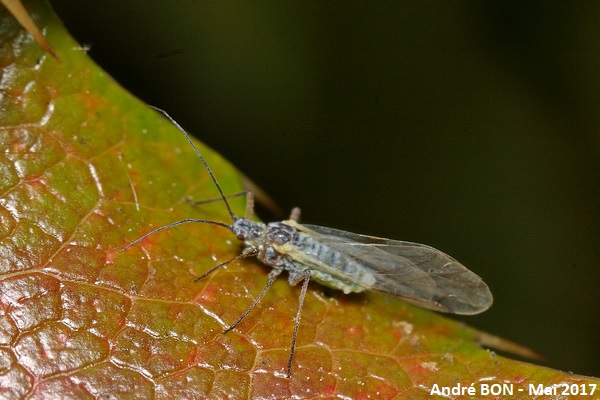

| Euceraphis sp. (Walker, 1870) |


|
|
Scientific name: Euceraphis sp. (Walker, 1870) Common name: French name: Order: Hemiptera Family: Aphididae Wingspan : 3-4.2 mm. Biotope: On Birches (Betula spp) and on Alders (alnus spp). Geographic area: Europe for Euceraphis punctipennis and for Euceraphis betulae. Furthermore Euceraphis betulae has been introduced to North America and to Australia. Observation period : The first annual generation becomes adult late May, early June. Sexual forms appear from September to November. The eggs laid after mating will over-winter and hatch out the following spring. |
Aphids of the Euceraphis genus grow on young shoots or under leaves of Birches or Alders. On Birches you mainly find the European Birch Aphid (Euceraphis punctipennis) or the Silver Birch Aphid (Euceraphis betulae). Adults are generally found singly while larvae and nymphs are found in small groups. Adults, which are always winged, show long legs and narrow wings. The antennae are about the same length as the body. The body is a pale green colour and it may be dusted with bluish white wax particles. The cornicles are short. There is a dark longitudinal stripe on the upper side of the head and two dark spots on the prothorax. There can be dark markings on the upper side of the abdomen, in particular on tergites IV and V. These markings are always missing on foundress of Euceraphis punctipennis in spring. However the most reliable method to separate both species is to compare the length of the sixth antennal article (L1) to the length of the second tarsi on the hind legs (L2) (very difficult to evaluate on picture). L1/L2 between 0.8 and 1.32 indicates Euceraphis betulae. L1/L2 between 1.33 and 1.75 indicates Euceraphis punctipennis. |
| [To know more about the Euceraphis sp.] [Next picture] [Top] |

|
I found this aphid on the underside of a Birch leaf in my garden. I took advantage of its immobility to shoot a close-up picture. You cannot compare the length of the sixth antennal article to the length of the second tarsi on the hind legs as they are not in the same plane. The lack of dark spots on the upper side of the abdomen and the date of the picture may lead to the Euceraphis punctipennis species but I am not sure this is enough to conclude. |
| [To know more about the Euceraphis sp.] [Previous picture] [Top] |

|
Here is one specimen dusted with bluish wax particles. |